Methylation-Sensitive Expression of a DNA Demethylase Gene Serves As an Epigenetic Rheostat
Organisms must adapt to dynamic and variable internal and external environments. Maintaining homeostasis in core biological processes is crucial to minimizing the deleterious consequences of environmental fluctuations. Genomes are also dynamic and variable, and must be robust against stresses, including the invasion of genomic parasites, such as transposable elements (TEs). In this work we present the discovery of an epigenetic rheostat in plants that maintains homeostasis in levels of DNA methylation. DNA methylation typically silences transcription of TEs. Because there is positive feedback between existing and de novo DNA methylation, it is critical that methylation is not allowed to spread and potentially silence transcription of genes. To maintain homeostasis, methylation promotes the production of a demethylase enzyme that removes methylation from gene-proximal regions. The demethylation of genes is therefore always maintained in concert with the levels of methylation suppressing TEs. In addition, this DNA demethylating enzyme also represses its own production in a negative feedback loop. Together, these feedback mechanisms shed new light on how the conflict between gene expression and genome defense is maintained in homeostasis. The presence of this rheostat in multiple species suggests it is an evolutionary conserved adaptation.
Published in the journal:
. PLoS Genet 11(3): e32767. doi:10.1371/journal.pgen.1005142
Category:
Research Article
doi:
https://doi.org/10.1371/journal.pgen.1005142
Summary
Organisms must adapt to dynamic and variable internal and external environments. Maintaining homeostasis in core biological processes is crucial to minimizing the deleterious consequences of environmental fluctuations. Genomes are also dynamic and variable, and must be robust against stresses, including the invasion of genomic parasites, such as transposable elements (TEs). In this work we present the discovery of an epigenetic rheostat in plants that maintains homeostasis in levels of DNA methylation. DNA methylation typically silences transcription of TEs. Because there is positive feedback between existing and de novo DNA methylation, it is critical that methylation is not allowed to spread and potentially silence transcription of genes. To maintain homeostasis, methylation promotes the production of a demethylase enzyme that removes methylation from gene-proximal regions. The demethylation of genes is therefore always maintained in concert with the levels of methylation suppressing TEs. In addition, this DNA demethylating enzyme also represses its own production in a negative feedback loop. Together, these feedback mechanisms shed new light on how the conflict between gene expression and genome defense is maintained in homeostasis. The presence of this rheostat in multiple species suggests it is an evolutionary conserved adaptation.
Introduction
In plants, animals, and fungi, DNA methylation is used to repress the transcription of potentially harmful DNA sequences [1]. Targets include long transposable elements (TEs) that have intact open reading frames and primarily reside in heterochromatin and shorter TE fragments that are prevalent in euchromatic gene-rich regions. In plants, DNA methylation is dynamically regulated during development and in response to external perturbations. Many of these changes occur at TEs or TE-derived sequences. Examples include modest DNA methylation changes in gene-proximal regions upon exposure to bacteria or bacterial elicitors [2,3] and DNA demethylation of TEs in the 5' regions of stress response genes during fungal infection [4]. Dynamic methylation changes have also been implicated in the regulation of genes in response to abiotic signals [5,6]. Furthermore, DNA methylation is dynamic during reproductive development. DNA demethylation in the female gametophyte is important for establishing gene imprinting in the endosperm after fertilization [7]. During male gametogenesis, the sperm become hypomethylated in certain sequence contexts [8]. Similar to other dynamic changes, the removal of methylation in gametophytes occurs largely at TE fragments in euchromatin.
DNA methylation patterns are a product of methylation and demethylation activities, but how these opposing activities are balanced in the genome is unknown. In plants, DNA methylation is established and maintained in different cytosine sequence contexts by genetically distinct pathways. Euchromatic TEs in Arabidopsis and maize are primarily targeted for cytosine methylation through the process of RNA-directed DNA methylation (RdDM), which results in cytosine methylation in all sequence contexts (CG, CHG, and CHH, where H represents any base other than G) [1,9]. This process is initiated by transcription of non-coding RNAs by a specialized RNA polymerase unique to plants, RNA Pol IV. These non-coding RNAs are then converted into dsRNAs by the RNA-dependent RNA polymerase RDR2. Small 24 nt RNAs generated from these transcripts are then loaded into AGO4. The small RNAs are thought to interact with non-coding transcripts that are generated by a second plant-specific polymerase, RNA Pol V [10], resulting in the recruitment of the de novo methyltransferase DRM2 and sequence-specific DNA methylation. 21–22 nt small RNAs generated through an RDR6-dependent pathway can also direct de novo methylation independently of RNA Pol IV [11,12]. Positive feedback between existing and de novo DNA methylation reinforces silencing [13,14]. Maintenance of asymmetric CHH methylation requires continual de novo methylation by RdDM. Other processes maintain DNA methylation in the CG and CHG sequence context. CG DNA methylation is maintained by the maintenance methyltransferase MET1 in conjunction with VIM methyl-binding proteins. CHG methylation is maintained by CMT3 and is positively reinforced by histone H3K9 dimethylation [15]. By contrast, TEs in heterochromatic sequences are methylated by CMT2 with the assistance of the nucleosome remodeler DDM1 [16,17].
Because there is positive feedback between methylation and further RdDM activity and because many RdDM targets are near genes, it is important that mechanisms are in place to protect genes from potentially detrimental hypermethylation. In the Arabidopsis genome, 44% of genes have a TE within 2 kb of the transcribed region [18], potentially creating a conflict between TE suppression by RdDM and gene expression. DNA methylation is opposed by 5-methylcytosine DNA glycosylases that remove methylcytosine from DNA by base excision repair. Plants with mutations in the three DNA glycosylases expressed in somatic tissues, ROS1, DML2, and DML3, gain methylation in all sequence contexts in gene proximal regions, primarily around TEs and TE-derived sequences [19,20]. DNA demethylation is therefore important to protect genes from RdDM spreading. This has been demonstrated at several loci. For example, the EPF2 gene, which is associated with a methylated TE approximately 1.5 kb 5’ of its transcriptional start site, gains methylation in the region between the TE and 5’ end of the gene in ros1 dml2 dml3 mutants, resulting in transcriptional silencing [21]. Although DNA methylation is primarily thought of as repressive to transcription [20,22], expression of the DNA demethylase gene ROS1 is unexpectedly reduced in some DNA methylation mutants [23–26]. Whether this is a direct or indirect effect has not been demonstrated. These observations on ROS1 expression form the basis of our study.
Here we describe the existence of a rheostat for genomic methylation activity. We find that RdDM and DNA demethylation activities converge on TE-derived sequences 5’ of ROS1. In contrast to other genomic targets of these pathways, expression of ROS1 is promoted by the RdDM pathway and inhibited by demethylation by ROS1. Thus the ROS1 locus functions as a self-regulating epigenetic rheostat, balancing input from both DNA methylation and demethylation to maintain homeostasis between these opposing systems.
Results
RNA-directed DNA methylation promotes ROS1 expression
Previous studies have shown that ROS1 expression is reduced in mutants in which DNA methylation is disrupted or altered [23–26]. Additionally, expression of the ROS1 gene is significantly reduced when plants are grown on the methyltransferase inhibitor 5-aza-2-deoxycytidine (5-azaC) [24] (Fig 1A). Here we systematically evaluated which DNA methylation pathways promote ROS1 expression by performing RT-qPCR on multiple Arabidopsis mutants that directly or indirectly alter DNA methylation. met1 plants have pleiotropic methylation phenotypes; methylation in CG, CHG and CHH sequence contexts is reduced genome-wide in combination with local regions of non-CG hypermethylation [20]. We observed extremely low levels of ROS1 transcripts in met1 and vim seedlings (Fig 1B), as has been reported previously [23,24]. An approximately ten-fold decrease in ROS1 transcript levels was observed in eleven different RdDM mutants (Fig 1C), consistent with previous findings that ROS1 expression is reduced in rdr2, nrpd1a, nrpe1, drd1, and drm2 mutants [23,25]. RdDM is predominantly associated with transcriptional repression; therefore transcriptional activation of ROS1 by RdDM potentially represents an under appreciated function for this pathway. Transcripts from the related 5-methylcytosine DNA glycosylases DML2 and DML3 are present at much lower levels than ROS1 in wild-type tissues (S1 Fig). Mutations in the RdDM pathway do not alter the transcript abundance of DML2, and result in small reductions in DML3 (S1 Fig). No significant changes to ROS1 transcript abundance were observed in CHG methyltransferase mutants (Fig 1D), in mutants of key regulators of histone H3K9 methylation (Fig 1D), which is tightly associated with CHG methylation [27], in plants with mutations in genes required to establish non-CG methylation in heterochromatin [16,17] (Fig 1E), or in plants with a mutation in the RDR6 gene, which can trigger de novo methylation independently of the canonical RdDM pathway [11,12] (Fig 1E). Thus, ROS1 down-regulation in methylation mutants is restricted to mutations in MET1 and its cofactors, and mutations in the RdDM pathway.
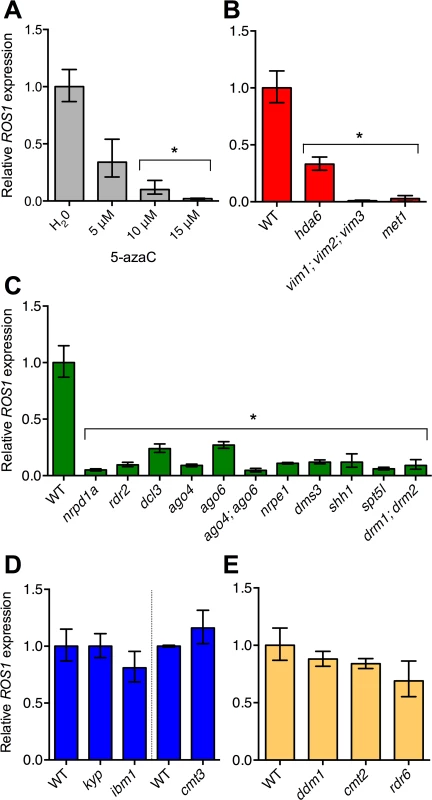
To test if ROS1 silencing in met1 or RdDM mutants was heritable, we crossed met1, rdr2, and drm1; drm2 plants to wild type and evaluated ROS1 expression in heterozygous F1 progeny. ROS1 expression remained reduced in MET1/met1 F1 progeny at levels about half that of wild type plants, regardless of whether the met1 plant served as the male or female parent in the cross (Fig 2A). This suggests that the ROS1 allele inherited from the met1 parent remained silenced through meiosis. However, ROS1 expression was gradually restored as MET1/met1 progeny developed (Fig 2B). Thus, erasure of met1-induced epigenetic changes and restoration of normal regulatory mechanisms at ROS1 likely takes place over multiple cell divisions. By contrast, ROS1 transcripts were restored to wild-type levels in F1 progeny of RdDM mutants crossed to wild type (Fig 2C).
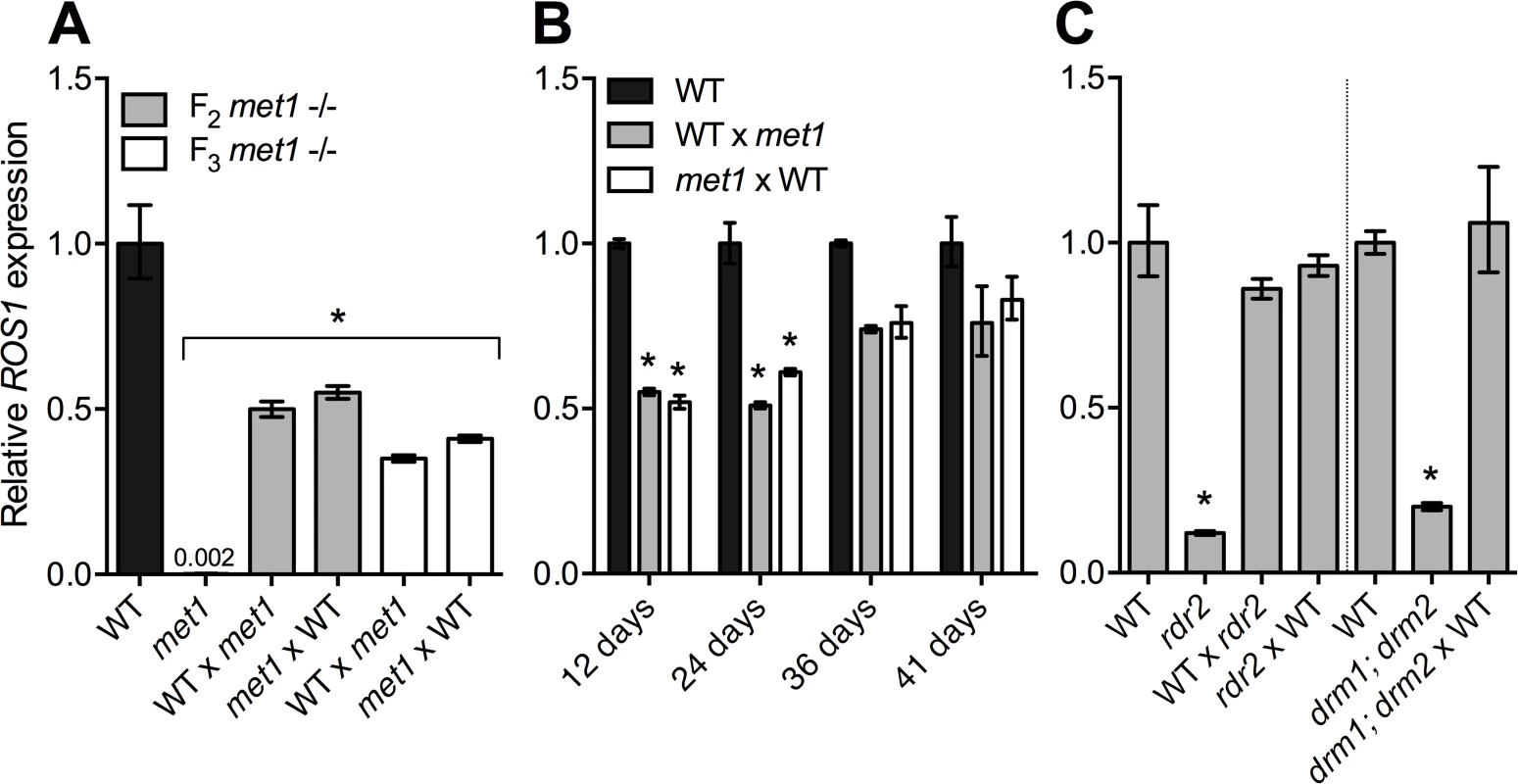
Recently it has been shown that reduced expression of the histone demethylase gene IBM1 contributes to reduced ROS1 expression in met1 mutants [26]. However, we found that ROS1 expression is not reduced in ibm1 mutants (Fig 1D), nor is IBM1 expression reduced in the RdDM mutants rdr2 and nrpd1a (RNA Pol IV) (S2 Fig), suggesting that the decreased expression of ROS1 expression in RdDM mutants is IBM1-independent. Together these data indicate that the down-regulation of ROS1 observed in met1 and RdDM mutants represents distinct processes, which was further supported by methylation profiling of ROS1 in different mutant backgrounds, described below.
RdDM is highly active at a TE 5' of ROS1
To determine if the ROS1 locus is targeted directly by DNA methylation, we performed bisulfite PCR and sequencing of the entire ROS1 gene and 1 kb of 5’ flanking sequences (Fig 3, S3 Fig). In wild-type plants we identified two small regions where cytosines were methylated in CG, CHG, and CHH sequence contexts (a hallmark of RdDM): a 228 bp region partially overlapping an AtREP5 Helitron TE directly upstream of ROS1, and in sequences encoding exons 15–18 (Fig 3). Genome-wide chromatin-IP datasets [10,28] showed that peaks of the RdDM proteins NRPE1 (RNA Pol V) and AGO4 were present 5' of the ROS1 start codon, overlapping the nearby TE (Fig 2). This is the same region where an RNA Pol V transcript has been detected [10]. There were high levels of CHH methylation in this region, predominantly on the top strand (Fig 2, S3 Fig), and we identified multiple 24 nucleotide small RNAs directly matching this sequence from published datasets (Fig 3) [29,30]. In addition, we detected multiple small RNAs matching the methylated exons within the ROS1 coding region, but these did not overlap with peaks in the AGO4 or NRPE1 ChIP datasets, consistent with the low levels of CHH methylation in this region (Fig 3). To determine the proximity of the 5' methylated region to the ROS1 transcriptional start site (TSS), we performed 5' RACE using RNA from wild-type Col-0 seedlings and identified two transcription start sites, 26 and 442 bp 5’ of the ROS1 start codon (S3 Fig), the latter of which is within 100 bp of the methylated region.
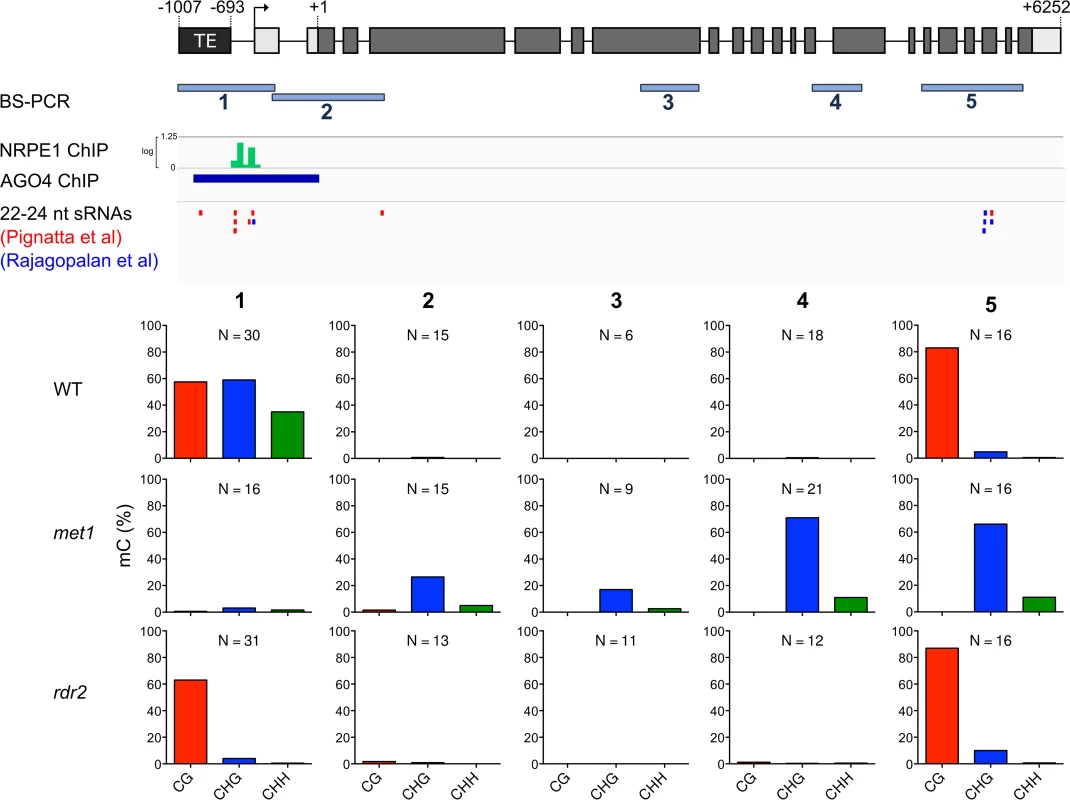
We also profiled ROS1 methylation in met1 and rdr2 mutants. CG methylation was eliminated in met1, but the ROS1 coding region was hypermethylated in the CHG context (Fig 2), as has been previously reported [26]. We did not observe any evidence for coding region hypermethylation in rdr2 mutants. Instead, there was a clear reduction in non-CG methylation 5’ of the ROS1 TSS in rdr2 plants, as typically occurs when RdDM activity is lost (Fig 3, S3 Fig). Thus the TE at the 5' end of ROS1 is the most likely candidate as the site of RdDM activity that promotes ROS1 expression, despite the fact that methylated TEs 5' of genes are typically associated with transcriptional repression [18,20,21]. Combined with the distinct behavior of ROS1 alleles inherited from met1 or rdr2 parents (Fig 2), we propose that the RdDM pathway acts to promote ROS1 expression via a different mechanism than does the MET1 pathway.
Methylation 5’ of ROS1 is sufficient to restore ROS1 expression in rdr2 mutants
Although our results suggest that ROS1 expression is positively correlated with DNA methylation at the ROS1 locus, reduced expression of ROS1 in RdDM mutants could be direct or indirect, for example due to altered expression of a ROS1 regulator. To distinguish between these possibilities we sought to restore DNA methylation at the ROS1 5’ region in an rdr2 mutant background and then observe the effect on ROS1 expression. We attempted to bypass the inability of the rdr2 mutant to make a dsRNA that initiates RdDM by expressing an inverted repeat transgene under the control of the constitutive 35S promoter in rdr2 mutants (Fig 4A). Transcription of inverted repeat transgenes creates a double-stranded hairpin RNA that can be processed into small RNAs that direct DNA methylation [31]. We used inverted repeats corresponding precisely to the 228 bp ROS1 5’ region that is methylated in wild type. We screened rdr2 T1 plants for methylation of the ROS1 5’ region and focused on six lines for in-depth analysis of DNA methylation by bisulfite sequencing (Fig 4B). Methylation in each of the six lines was restored to varying degrees, constituting an epiallelic series, with some lines exhibiting a methylation profile strikingly similar to wild type. Methylation occurred in all sequence contexts, indicative of RNA-directed DNA methylation. ROS1 expression was examined in leaves of each independent line by RT-qPCR (Fig 4C). Remarkably, ROS1 expression was restored in rdr2 mutants when methylation of the 5’ region was restored. In a transgenic line with limited restoration of DNA methylation (line #19), ROS1 expression increased only marginally in rdr2 mutants (Fig 4C). These data demonstrate that methylation of the 5’ sequence is sufficient to promote ROS1 expression, and eliminate the possibility that decreased expression of ROS1 in rdr2 mutants is caused by an indirect mechanism.
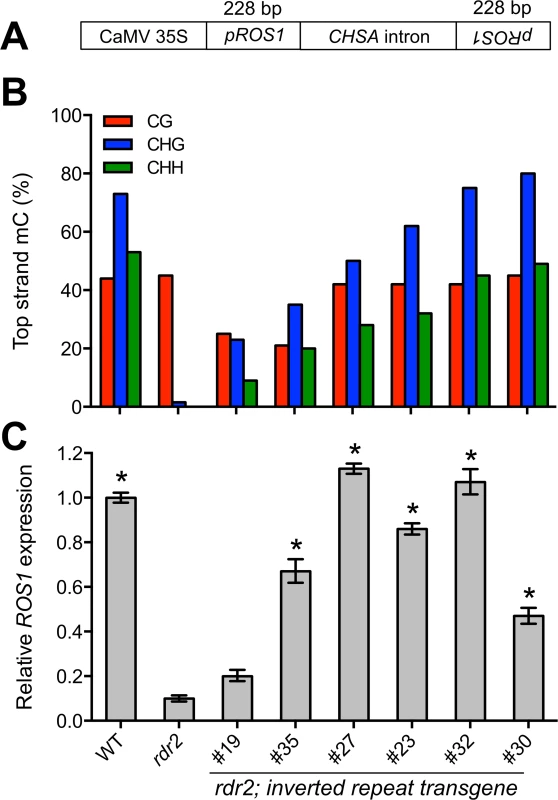
ROS1 directly opposes RdDM to repress ROS1 expression
We noticed that cytosines in the CG context 5’ of ROS1 were intermediately methylated at around 50% in wild-type tissues, with independent variance at every CG position in the sequence (Fig 3, S3 Fig). CG methylation is faithfully copied by MET1 during DNA replication, and so average methylation at symmetric CG sites is usually close to 0 or 100% [20]. The observed intermediate level of CG methylation and the low frequency of bisulfite clones fully methylated in the CG context (S3 Fig) suggested that active DNA demethylation might also be active at the 5’ sequence. We hypothesized that ROS1 might oppose RdDM to remove methylation at its own promoter. We performed bisulfite sequencing of the 5' methylated region in two missense mutants of ROS1, ros1-2 [32] and ros1-7, an allele encoding a protein with an E956K substitution in the ROS1 DNA glycosylase domain [33]. Symmetric CG methylation increased to nearly 100% in both mutants compared to their wild-type siblings, along with increases in non-CG methylation (Fig 5A), indicating that ROS1 actively removes methylation from this region in wild-type plants. At other loci, removal of 5' methylation by ROS1 increases transcription [21]. We examined the effect of DNA demethylation by ROS1 on ROS1 transcription by performing RT-qPCR on ros1-2 and ros1-7 mutants. Because these are missense mutations, nonsense-mediated decay should not be a complicating factor in measuring transcript abundance. ROS1 transcripts were 2 to 4-fold more abundant in ros1 mutants (Fig 5B). This suggests that active demethylation by ROS1 represses transcription of ROS1, counteracting the function of the RdDM pathway, which promotes ROS1 expression. Thus ROS1 regulates the expression of its own gene, forming a negative feedback loop for demethylation activity.
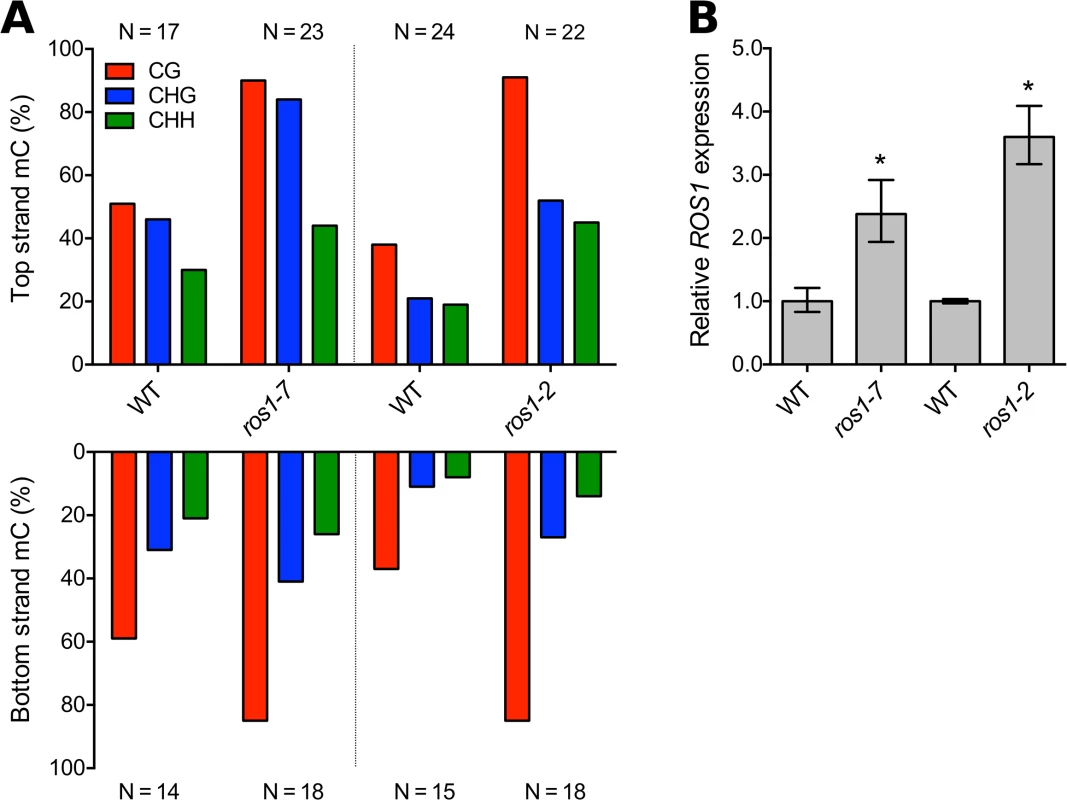
Methylation-sensitive regulation of ROS1 is conserved in other species
To determine if regulation of ROS1 by methylation might be adaptive, we assessed whether methylation-sensitive expression of ROS1 is conserved in other species. Arabidopsis lyrata, which diverged from A. thaliana approximately 10 million years ago, has two highly conserved paralogs of ROS1 in tandem in the genome, which we termed AlROS1a and AlROS1b (Fig 6A). We performed a Bayesian reconstruction of the phylogeny of ROS1 homologs within all sequenced Brassicales (Fig 6B) and found that the duplication giving rise to the two ROS1 paralogs in A. lyrata occurred prior to the divergence of A. lyrata from A. thaliana. AtROS1 belongs to the same clade as AlROS1a, and no true homologs to AlROS1b exist in A. thaliana (Fig 6B). The homolog to AlROS1b was likely lost in the lineage that gave rise to A. thaliana. AlROS1a and AlROS1b share a high degree of sequence similarity in their coding region, but no significant similarity in their upstream sequences. Only AlROS1a has an upstream region conserved with AtROS1 (Fig 6A), including the presence of the same 5’ TE. The 5’ sequences are 78% identical over the first 1.4 kb.
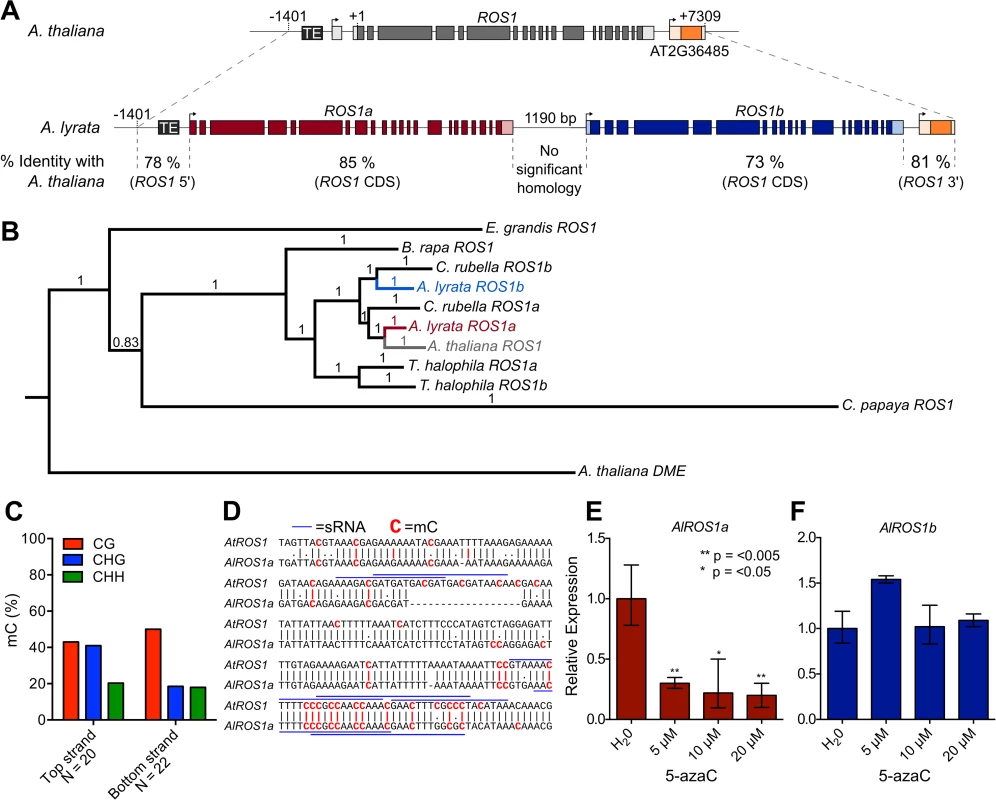
We performed bisulfite sequencing of the AlROS1a 5’ region (Fig 6C) and of the exonic sequences in AlROS1a and AlROS1b that match exons 15–18 in ROS1 (S4 Fig). Although CG methylation was present in the 3’ exonic region of both paralogs, non-CG methylation was absent (S4 Fig). Additionally, unlike A. thaliana, we did not find any small RNAs matching these exons for either AlROS1a or AlROS1b in a small RNA dataset from A. lyrata flowers [34]. By contrast, the methylation profile 5’ of AlROS1a was remarkably similar to the methylation profile 5' of AtROS1 (Fig 6C and 6D and Fig 3). Like AtROS1, CG methylation in the 5’ region was at an intermediate level between 40–50%, suggesting that RdDM and active DNA demethylation might also simultaneously target AlROS1a. Pair-wise alignment of the sequences from each species showed that the methylation was present at conserved cytosines (Fig 6D). Furthermore, we identified small RNAs from A. lyrata datasets [34] that are almost identical to the small RNAs associated with methylation at the 5' end of AtROS1 (Fig 6D). The methylated sequence matching these RNAs is directly adjacent to a homolog of the AtREP5 TE upstream of AtROS1 (Fig 6A). These data indicate that RdDM targeting to a region 5’ of the ROS1 TSS is evolutionarily conserved.
To test whether the expression of either AlROS1 paralog was responsive to methylation alterations, A. lyrata seedlings were grown on varying concentrations of 5-azaC. AlROS1a but not AlROS1b transcripts were significantly decreased in seedlings grown on 5-azaC (Fig 6E and 6F). Thus expression of the true A. lyrata homolog of ROS1, AlROS1a, which has similar 5’ methylation and conserved small RNAs, is methylation-responsive. Together, these data suggest that the regulation of ROS1 by RdDM and DNA demethylation at 5’ sequences is conserved between A. thaliana and A. lyrata. Interestingly, in transcriptome datasets from shoot apical meristems or immature ears of Z. mays mop1 mutants (Mop1 is an RDR2 homologue), expression of two DNA glycosylase genes with high homology to AtROS1 (DNG101 and DNG103) was reduced 2 to 3.3-fold in comparison to wild type [35,36]. Reduced expression of ROS1 homologs has also been observed in the transcriptome of Z. mays RNA polymerase IV mutants [37]. We confirmed that DNA glycosylase expression is reduced in mop1 leaves by RT-qPCR (S5 Fig). Both DNG101 and DNG103 have methylated TEs in their 5' region in all sequence contexts, suggesting that both loci could be direct targets of RdDM [38]. These data further suggest that regulation of DNA glycosylases by RdDM might be a general feature of angiosperms, and thus likely adaptive.
Discussion
Our data demonstrate that ROS1 functions as a self-regulating epigenetic rheostat. RdDM and DNA demethylation activities converge at the ROS1 locus, but each activity has the opposite outcome on ROS1 transcript abundance as compared to typical targets of these processes (Fig 7). By establishing DNA methylation at the ROS1 locus in rdr2 mutants (Fig 4), we have conclusively shown that methylation of the 5’ sequence is sufficient to restore ROS1 expression. Thus reduced expression of ROS1 in rdr2 mutants is not caused by an indirect mechanism, such as decreased expression of another gene required for ROS1 expression or increased expression of a negative regulator of ROS1. While the precise mechanism by which the activity of ROS1 is repressive and RdDM is activating remains unknown, we speculate that a protein that either negatively or positively regulates ROS1 may exhibit differential DNA binding affinity based on methylation of the underlying ROS1 5’ DNA sequence. Alternatively, it is possible that rather than DNA methylation itself, the act of RdDM could play a regulatory role. For example, occupancy, DNA melting or elongation by RNA polymerases IV or V could be required for positive regulatory factors to access ROS1. Interestingly, RdDM in an intron of the MADS3 gene in Petunia has also been shown to be associated with transcriptional upregulation [39]. In this instance, it is likely that methylation of a short cis-element is necessary to confer increased expression.
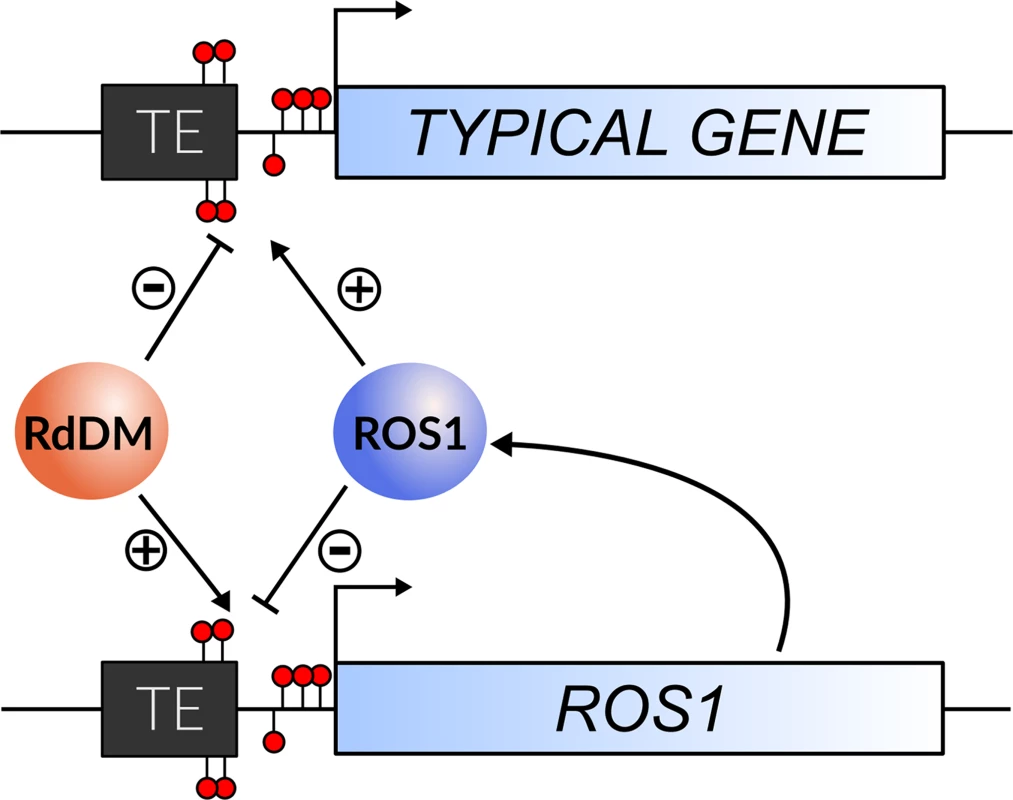
The reversal of methylation outcomes at ROS1 permits the genome to maintain gene expression (promoted by DNA demethylation) and genome defense (TE silencing by RdDM) in homeostatic balance. For example, if the genome were under stress from high TE transcriptional activity or invasion, RdDM activity might increase. Under these conditions, RdDM activity would promote the expression of ROS1, so that the activity of demethylation at target genes would be maintained in equilibrium with the activity of RdDM in the genome (Fig 7). Conversely, if RdDM were less active, ROS1 expression would be reduced to prevent hypomethylation as a consequence of demethylation activity. The result is that the expression of ROS1 is always maintained in balance by its autoregulation (Fig 7), which may help underpin the regulation of epigenetic homeostasis within plants and explain why spontaneous changes to methylation are generally very rare [40,41]. This homeostatic balance may be dynamically modified in certain conditions, such as fungal or bacterial infections, where active demethylation of defense genes is important for resistance [2–4]. The rheostat may also be important during normal development. In pollen, DRM2 is expressed at a low level in microspores and sperm [8]. In agreement with our findings from drm2 and other RdDM mutants, ROS1 transcripts have not been detected in wild-type sperm [42]. Published methylation profiling data from pollen show that the ROS1 5’ region is hypomethylated in sperm cells, but not in the vegetative nucleus (S6 Fig), where both DRM2 and ROS1 are expressed [42,43]. In the future, it will be important to determine whether disrupting the rheostat has consequences for the proper establishment of methylation patterns in sperm or in developing progeny after fertilization.
In addition to the methylation-responsive regulation of ROS1 that we have described here, it is possible that additional mechanisms underlie epigenetic homeostasis in Arabidopsis. Targeting of RdDM, H3K9 methylation, and H3K27 methylation are redirected throughout the genome in met1 mutants [20,24,44], and it has been hypothesized that this redirection may be the result of compensatory mechanisms necessary to maintain some level of integrity in gene expression [24]. Therefore, other mechanisms may also regulate repressive histone modifications in balance with gene expression. The role of methylation in promoting IBM1 expression [26] may be one such example. Although our experiments have focused on Arabidopsis species, the concept of epigenetic homeostasis might also apply more broadly to other DNA methylation systems, including those in mammals. It is known that the cancer epigenome exhibits global DNA hypomethylation and local hypermethylation [45], which is broadly similar to the methylation phenotype of a met1 mutant. Interestingly, expression of the three TET enzymes, which are responsible for initiating DNA demethylation in mammals by oxidizing 5-methylcytosine, is reduced in multiple cancers [46].
We conclude that the ROS1 locus serves as a rheostat for methylation levels. We propose that the ROS1 epigenetic rheostat evolved to counter-balance positive feedback between DNA methylation and RdDM activity [13,14] to prevent ectopic gain of DNA methylation. The conservation of methylation-sensitive ROS1 expression among divergent angiosperms suggests that this regulation is adaptive and could underpin how plants balance a number extremely effective, potent, and self-reinforcing silencing mechanisms while maintaining gene transcription.
Materials and Methods
Plant growth conditions
Arabidopsis thaliana, Arabidopsis lyrata, and Zea mays plants were grown in a greenhouse with 16-hour days at 21°C. For experiments performed on whole seedlings, plants were grown on 0.5 x MS medium with 5% agar. For treatment with 5-azaC, A. thaliana or A. lyrata seedlings were grown on filter paper moistened with water or 5, 10, 15 or 20 μM 5-aza-2-deoxycytidine. Fresh water or 5-azaC was added daily. The accession number for all mutant plants used in this study are in S1 Text.
Quantitative RT-PCR
Total RNA was extracted using an RNeasy Plant Mini Kit (Qiagen). RNA was extracted from whole 7-day old Arabidopsis thaliana seedlings for all experiments, except for experiments using 5-azaC, in which case 5-day old A. thaliana or A. lyrata seedlings were used, or experiments with transgenic lines expressing a ROS1 inverted repeat construct, in which case rosette leaves from 21-day old plants were used. RNA was extracted from the tip of the third true leaf of maize plants. For each genotype, 3 biological replicates of at least 5 pooled individual seedlings (Arabidopsis) or individual plants (maize) were collected. Genomic DNA was removed using amplification-grade DNAseI (Invitrogen). cDNA was synthesized from 500 ng RNA using Superscript II reverse transcriptase (Invitrogen) according to manufacturers’ instructions, selecting for polyadenylated transcripts using an oligo-dT primer. For each cDNA synthesis reaction, a control was performed without addition of reverse transcriptase to test the efficacy of the DNAse treatment. Quantitative RT-PCR (RT-qPCR) was performed using Fast Sybr-Green mix (Applied Biosystems) according to manufacturers’ instructions. All reactions were performed using a StepOne Plus Real-Time PCR system (Applied Biosystems). Primers were designed to have matching melting temperatures between 60–65 °C and to produce amplicons between 80–160 bp in length. All primers were used in a final concentration of 400 nM. The efficiency of all primer pairs was verified using a standard curve dilution of template cDNA prior to their use in quantification of transcripts. Melt curves were analyzed to verify the presence of one amplicon in each reaction, and representative products were also verified by agarose gel electrophoresis. Relative expression was calculated using the ddCt method as described [47]. For Arabidopsis, the reference transcript used for all reactions was AT1G58050, experimentally verified to be one of the most consistently abundant transcripts in A. thaliana [48]. For maize, the reference transcript was ZmEF1α, defined to be the most consistent reference transcript over the majority of experimental conditions [49]. Primer sequences are available in the S1 Text.
Rapid Amplification of cDNA ends (RACE)
5' RACE of ROS1 was performed using 10 μg Col-0 RNA extracted from 10-day old seedlings. The 5' RACE cDNA library was synthesized using a FIRST-CHOICE RLM-RACE Kit (Ambion) according to manufacturers’ instructions, with the exception that a ROS1-specific oligonucleotide was used to prime cDNA synthesis. RACE products were amplified using a nested PCR strategy, purified using a QIAquick gel extraction kit (Qiagen) and cloned for sequencing using a TOPO-Blunt PCR cloning kit (Invitrogen).
Bisulfite sequencing
Genomic DNA was isolated from 7-day old seedlings or 21-day old rosette leaves using a CTAB procedure. 2 μg DNA were sheared by sonication and used for bisulfite treatment, which was performed as described [50]. 2 μl bisulfite treated DNA was used in PCR reactions with 2.5 U ExTaq DNA polymerase (Takara) and 0.4 μM primers using the following cycling conditions (95 °C 3 minutes, 40 cycles of [95 °C for 15 seconds, 52 °C for 60 seconds, 72 °C for 60 seconds], 72 °C for 10 minutes). PCR products were cloned using TOPO-TA (Invitrogen) or CloneJet (Life Technologies) PCR cloning kit and individual colonies were sequenced. Sequenced products were aligned using MUSCLE [51], and methylation of each cytosine residue was calculated using CyMate [52].
Inverted repeat transgene
The 228 bp sequence 5' of ROS1 that is targeted by RdDM in wild-type plants was amplified and cloned into the directional entry vector pENTR-TOPO-D (Invitrogen). The sequence was then inserted twice in an inverted repeat conformation into the vector pANDA-35HK using a single LR clonase reaction as described by [53]. rdr2 mutant plants were transformed with the inverted repeat transgene by floral dipping [54], and T1 lines were screened for DNA methylation 5' of ROS1 using a restriction enzyme assay on bisulfite treated DNA. 90% of lines screened exhibited higher DNA methylation than rdr2 and nrpe1 mutants. Six lines covering a range of methylated epigenotypes were selected for bisulfite sequencing and expression analysis.
Bayesian reconstruction of phylogeny
Coding sequences for ROS1 homologs from all fully sequenced genomes within Brassicales were downloaded from Phytozome 9.1. In addition, the coding sequence for Arabidopsis thaliana DME, which belongs to a distinct clade of DNA glycosylases [55], was included as an out-group. Sequences were aligned using Muscle 3.8 [51], and manually verified using Aliview [56]. The phylogeny was reconstructed from the aligned matrix using MrBayes 3.1.2 [57]. jModelTest [58] was used to determine the ideal model for analysis, and the general time reversible model with gamma distributed rate variation was chosen. Gaps were treated as missing data. The analysis was run for 2,500,000 generations sampling every 100 trees. By this time the average standard deviation of split frequencies had reached <0.01 and the potential scale reduction factor (PRSF) was <1.005 for all parameters. The first 25% of trees were discarded as burn-in and the output phylogeny was further analyzed and annotated using FigTree 1.4.
Supporting Information
Zdroje
1. Law JA, Jacobsen SE. Establishing, maintaining and modifying DNA methylation patterns in plants and animals. Nat Rev Genet. 2010;11: 204–220. doi: 10.1038/nrg2719 20142834
2. Dowen RH, Pelizzola M, Schmitz RJ, Lister R, Dowen JM, Nery JR, et al. Widespread dynamic DNA methylation in response to biotic stress. Proc Natl Acad Sci. 2012;109: E2183–E2191. doi: 10.1073/pnas.1209329109 22733782
3. Yu A, Lepère G, Jay F, Wang J, Bapaume L, Wang Y, et al. Dynamics and biological relevance of DNA demethylation in Arabidopsis antibacterial defense. Proc Natl Acad Sci. 2013;110: 2389–2394. doi: 10.1073/pnas.1211757110 23335630
4. Le T-N, Schumann U, Smith NA, Tiwari S, Au PC, Zhu Q-H, et al. DNA demethylases target promoter transposable elements to positively regulate stress responsive genes in Arabidopsis. Genome Biol. 2014;15: 458. doi: 10.1186/s13059-014-0458-3 25228471
5. Steward N, Ito M, Yamaguchi Y, Koizumi N, Sano H. Periodic DNA Methylation in Maize Nucleosomes and Demethylation by Environmental Stress. J Biol Chem. 2002;277: 37741–37746. 12124387
6. Ariel F, Jegu T, Latrasse D, Romero-Barrios N, Christ A, Benhamed M, et al. Noncoding Transcription by Alternative RNA Polymerases Dynamically Regulates an Auxin-Driven Chromatin Loop. Mol Cell. 2014;55: 383–396. doi: 10.1016/j.molcel.2014.06.011 25018019
7. Gehring M, Bubb KL, Henikoff S. Extensive Demethylation of Repetitive Elements During Seed Development Underlies Gene Imprinting. Science. 2009;324: 1447–1451. doi: 10.1126/science.1171609 19520961
8. Calarco JP, Borges F, Donoghue MTA, Van Ex F, Jullien PE, Lopes T, et al. Reprogramming of DNA Methylation in Pollen Guides Epigenetic Inheritance via Small RNA. Cell. 2012;151: 194–205. doi: 10.1016/j.cell.2012.09.001 23000270
9. Gent JI, Madzima TF, Bader R, Kent MR, Zhang X, Stam M, et al. Accessible DNA and Relative Depletion of H3K9me2 at Maize Loci Undergoing RNA-Directed DNA Methylation. Plant Cell Online. 2014; tpc.114.130427.
10. Zheng Q, Rowley MJ, Böhmdorfer G, Sandhu D, Gregory BD, Wierzbicki AT. RNA polymerase V targets transcriptional silencing components to promoters of protein-coding genes. Plant J. 2013;73: 179–189.
11. Pontier D, Picart C, Roudier F, Garcia D, Lahmy S, Azevedo J, et al. NERD, a Plant-Specific GW Protein, Defines an Additional RNAi-Dependent Chromatin-Based Pathway in Arabidopsis. Mol Cell. 2012;48: 121–132. doi: 10.1016/j.molcel.2012.07.027 22940247
12. McCue AD, Nuthikattu S, Reeder SH, Slotkin RK. Gene Expression and Stress Response Mediated by the Epigenetic Regulation of a Transposable Element Small RNA. PLoS Genet. 2012;8: e1002474. doi: 10.1371/journal.pgen.1002474 22346759
13. Johnson LM, Du J, Hale CJ, Bischof S, Feng S, Chodavarapu RK, et al. SRA- and SET-domain-containing proteins link RNA polymerase V occupancy to DNA methylation. Nature. 2014;507: 124–128. doi: 10.1038/nature12931 24463519
14. Zhong X, Du J, Hale CJ, Gallego-Bartolome J, Feng S, Vashisht AA, et al. Molecular Mechanism of Action of Plant DRM De Novo DNA Methyltransferases. Cell. 2014;157: 1050–1060. doi: 10.1016/j.cell.2014.03.056 24855943
15. Lindroth AM, Shultis D, Jasencakova Z, Fuchs J, Johnson L, Schubert D, et al. Dual histone H3 methylation marks at lysines 9 and 27 required for interaction with CHROMOMETHYLASE3. EMBO J. 2004;23: 4286–4296. 15457214
16. Zemach A, Kim MY, Hsieh P-H, Coleman-Derr D, Eshed-Williams L, Thao K, et al. The Arabidopsis Nucleosome Remodeler DDM1 Allows DNA Methyltransferases to Access H1-Containing Heterochromatin. Cell. 2013;153: 193–205. doi: 10.1016/j.cell.2013.02.033 23540698
17. Stroud H, Do T, Du J, Zhong X, Feng S, Johnson L, et al. Non-CG methylation patterns shape the epigenetic landscape in Arabidopsis. Nat Struct Mol Biol. 2014;21: 64–72. doi: 10.1038/nsmb.2735 24336224
18. Wang X, Weigel D, Smith LM. Transposon Variants and Their Effects on Gene Expression in Arabidopsis. PLoS Genet. 2013;9: e1003255. doi: 10.1371/journal.pgen.1003255 23408902
19. Penterman J, Zilberman D, Huh JH, Ballinger T, Henikoff S, Fischer RL. DNA demethylation in the Arabidopsis genome. Proc Natl Acad Sci. 2007;104: 6752–6757. 17409185
20. Lister R, O’Malley RC, Tonti-Filippini J, Gregory BD, Berry CC, Millar AH, et al. Highly Integrated Single-Base Resolution Maps of the Epigenome in Arabidopsis. Cell. 2008;133: 523–536. doi: 10.1016/j.cell.2008.03.029 18423832
21. Yamamuro C, Miki D, Zheng Z, Ma J, Wang J, Yang Z, et al. Overproduction of stomatal lineage cells in Arabidopsis mutants defective in active DNA demethylation. Nat Commun. 2014;5.
22. Zilberman D, Gehring M, Tran RK, Ballinger T, Henikoff S. Genome-wide analysis of Arabidopsis thaliana DNA methylation uncovers an interdependence between methylation and transcription. Nat Genet. 2007;39: 61–69. 17128275
23. Huettel B, Kanno T, Daxinger L, Aufsatz W, Matzke AJM, Matzke M. Endogenous targets of RNA-directed DNA methylation and Pol IV in Arabidopsis. EMBO J. 2006;25: 2828–2836. 16724114
24. Mathieu O, Reinders J, Čaikovski M, Smathajitt C, Paszkowski J. Transgenerational Stability of the Arabidopsis Epigenome Is Coordinated by CG Methylation. Cell. 2007;130: 851–862. 17803908
25. Penterman J, Uzawa R, Fischer RL. Genetic Interactions between DNA Demethylation and Methylation in Arabidopsis. Plant Physiol. 2007;145: 1549–1557. 17951456
26. Rigal M, Kevei Z, Pélissier T, Mathieu O. DNA methylation in an intron of the IBM1 histone demethylase gene stabilizes chromatin modification patterns. EMBO J. 2012;31: 2981–2993. doi: 10.1038/emboj.2012.141 22580822
27. Bernatavichute YV, Zhang X, Cokus S, Pellegrini M, Jacobsen SE. Genome-Wide Association of Histone H3 Lysine Nine Methylation with CHG DNA Methylation in Arabidopsis thaliana. PLoS ONE. 2008;3: e3156. doi: 10.1371/journal.pone.0003156 18776934
28. Zhong X, Hale CJ, Law JA, Johnson LM, Feng S, Tu A, et al. DDR complex facilitates global association of RNA polymerase V to promoters and evolutionarily young transposons. Nat Struct Mol Biol. 2012;19: 870–875. doi: 10.1038/nsmb.2354 22864289
29. Rajagopalan R, Vaucheret H, Trejo J, Bartel DP. A diverse and evolutionarily fluid set of microRNAs in Arabidopsis thaliana. Genes Dev. 2006;20: 3407–3425. 17182867
30. Pignatta D, Erdmann RM, Scheer E, Picard CL, Bell GW, Gehring M. Natural epigenetic polymorphisms lead to intraspecific variation in Arabidopsis gene imprinting. eLife. 2014;3: e03198. doi: 10.7554/eLife.03198 24994762
31. Luff B, Pawlowski L, Bender J. An inverted repeat triggers cytosine methylation of identical sequences in Arabidopsis. Mol Cell. 1999;3: 505–511. 10230403
32. Gong Z, Morales-Ruiz T, Ariza RR, Roldán-Arjona T, David L, Zhu J-K. ROS1, a Repressor of Transcriptional Gene Silencing in Arabidopsis, Encodes a DNA Glycosylase/Lyase. Cell. 2002;111: 803–814. 12526807
33. Till BJ, Reynolds SH, Greene EA, Codomo CA, Enns LC, Johnson JE, et al. Large-Scale Discovery of Induced Point Mutations With High-Throughput TILLING. Genome Res. 2003;13: 524–530. 12618384
34. Fahlgren N, Jogdeo S, Kasschau KD, Sullivan CM, Chapman EJ, Laubinger S, et al. MicroRNA Gene Evolution in Arabidopsis lyrata and Arabidopsis thaliana. Plant Cell Online. 2010;22: 1074–1089. doi: 10.1105/tpc.110.073999 20407027
35. Jia Y, Lisch DR, Ohtsu K, Scanlon MJ, Nettleton D, Schnable PS. Loss of RNA–Dependent RNA Polymerase 2 (RDR2) Function Causes Widespread and Unexpected Changes in the Expression of Transposons, Genes, and 24-nt Small RNAs. PLoS Genet. 2009;5: e1000737. doi: 10.1371/journal.pgen.1000737 19936292
36. Madzima TF, Huang J, McGinnis KM. Chromatin structure and gene expression changes associated with loss of MOP1 activity in Zea mays. Epigenetics. 2014;9: 1047–1059. doi: 10.4161/epi.29022 24786611
37. Erhard KF, Talbot J-ERB, Deans NC, McClish AE, Hollick JB. Nascent Transcription Affected by RNA Polymerase IV in Zea mays. Genetics. 2015; genetics.115.174714.
38. Li Q, Eichten SR, Hermanson PJ, Zaunbrecher VM, Song J, Wendt J, et al. Genetic Perturbation of the Maize Methylome. Plant Cell Online. 2014;26: 4602–4616. doi: 10.1105/tpc.114.133140 25527708
39. Shibuya K, Fukushima S, Takatsuji H. RNA-directed DNA methylation induces transcriptional activation in plants. Proc Natl Acad Sci. 2009;106: 1660–1665. doi: 10.1073/pnas.0809294106 19164525
40. Becker C, Hagmann J, Müller J, Koenig D, Stegle O, Borgwardt K, et al. Spontaneous epigenetic variation in the Arabidopsis thaliana methylome. Nature. 2011;480: 245–249. doi: 10.1038/nature10555 22057020
41. Schmitz RJ, Schultz MD, Lewsey MG, O’Malley RC, Urich MA, Libiger O, et al. Transgenerational Epigenetic Instability Is a Source of Novel Methylation Variants. Science. 2011;334: 369–373. doi: 10.1126/science.1212959 21921155
42. Schoft VK, Chumak N, Choi Y, Hannon M, Garcia-Aguilar M, Machlicova A, et al. Function of the DEMETER DNA glycosylase in the Arabidopsis thaliana male gametophyte. Proc Natl Acad Sci. 2011;108: 8042–8047. doi: 10.1073/pnas.1105117108 21518889
43. Ibarra CA, Feng X, Schoft VK, Hsieh T-F, Uzawa R, Rodrigues JA, et al. Active DNA Demethylation in Plant Companion Cells Reinforces Transposon Methylation in Gametes. Science. 2012;337: 1360–1364. doi: 10.1126/science.1224839 22984074
44. Deleris A, Stroud H, Bernatavichute Y, Johnson E, Klein G, Schubert D, et al. Loss of the DNA Methyltransferase MET1 Induces H3K9 Hypermethylation at PcG Target Genes and Redistribution of H3K27 Trimethylation to Transposons in Arabidopsis thaliana. PLoS Genet. 2012;8: e1003062. doi: 10.1371/journal.pgen.1003062 23209430
45. Baylin SB, Jones PA. A decade of exploring the cancer epigenome—biological and translational implications. Nat Rev Cancer. 2011;11: 726–734. doi: 10.1038/nrc3130 21941284
46. Yang H, Liu Y, Bai F, Zhang J-Y, Ma S-H, Liu J, et al. Tumor development is associated with decrease of TET gene expression and 5-methylcytosine hydroxylation. Oncogene. 2013;32: 663–669. doi: 10.1038/onc.2012.67 22391558
47. Livak KJ, Schmittgen TD. Analysis of Relative Gene Expression Data Using Real-Time Quantitative PCR and the 2-ddCt Method. Methods. 2001;25: 402–408. 11846609
48. Czechowski T, Stitt M, Altmann T, Udvardi MK, Scheible W-R. Genome-Wide Identification and Testing of Superior Reference Genes for Transcript Normalization in Arabidopsis. Plant Physiol. 2005;139: 5–17. 16166256
49. Lin Y, Zhang C, Lan H, Gao S, Liu H, Liu J, et al. Validation of Potential Reference Genes for qPCR in Maize across Abiotic Stresses, Hormone Treatments, and Tissue Types. PLoS ONE. 2014;9: e95445. doi: 10.1371/journal.pone.0095445 24810581
50. Xiao W, Gehring M, Choi Y, Margossian L, Pu H, Harada JJ, et al. Imprinting of the MEA Polycomb Gene Is Controlled by Antagonism between MET1 Methyltransferase and DME Glycosylase. Dev Cell. 2003;5: 891–901. 14667411
51. Edgar RC. MUSCLE: multiple sequence alignment with high accuracy and high throughput. Nucleic Acids Res. 2004;32: 1792–1797. 15034147
52. Hetzl J, Foerster AM, Raidl G, Scheid OM. CyMATE: a new tool for methylation analysis of plant genomic DNA after bisulphite sequencing. Plant J. 2007;51: 526–536. 17559516
53. Miki D, Shimamoto K. Simple RNAi Vectors for Stable and Transient Suppression of Gene Function in Rice. Plant Cell Physiol. 2004;45: 490–495. 15111724
54. Clough SJ, Bent AF. Floral dip: a simplified method for Agrobacterium-mediated transformation of Arabidopsis thaliana. Plant J. 1998;16: 735–743. 10069079
55. Zemach A, Kim MY, Silva P, Rodrigues JA, Dotson B, Brooks MD, et al. Local DNA hypomethylation activates genes in rice endosperm. Proc Natl Acad Sci. 2010;107: 18729–18734. doi: 10.1073/pnas.1009695107 20937895
56. Larsson A. AliView: a fast and lightweight alignment viewer and editor for large datasets. Bioinformatics. 2014; btu531.
57. Ronquist F, Huelsenbeck JP. MrBayes 3: Bayesian phylogenetic inference under mixed models. Bioinformatics. 2003;19: 1572–1574. 12912839
58. Posada D. jModelTest: Phylogenetic Model Averaging. Mol Biol Evol. 2008;25: 1253–1256. doi: 10.1093/molbev/msn083 18397919
59. Morton T, Petricka J, Corcoran DL, Li S, Winter CM, et al. Paired-End Analysis of Transcription Start Sites in Arabidopsis Reveals Plant-Specific Promoter Signatures. Plant Cell. 2014;26: 2746–2760. doi: 10.1105/tpc.114.125617 25035402
Štítky
Genetika Reprodukční medicínaČlánek vyšel v časopise
PLOS Genetics
2015 Číslo 3
Nejčtenější v tomto čísle
- Clonality and Evolutionary History of Rhabdomyosarcoma
- Morphological Mutations: Lessons from the Cockscomb
- Maternal Filaggrin Mutations Increase the Risk of Atopic Dermatitis in Children: An Effect Independent of Mutation Inheritance
- Transcriptomic Profiling of Reveals Reprogramming of the Crp Regulon by Temperature and Uncovers Crp as a Master Regulator of Small RNAs
